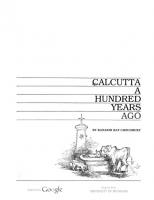A Chronicle of World History: From 130,000 Years Ago to the Eve of A.D. 2000 0761822534, 9780761822530
In A Chronicle of World History Frank King gives a centrist and universal survey, in chronological order, of world histo
216 105 28MB
English Pages 490 [494] Year 2002
Recommend Papers

- Author / Uploaded
- Frank King
File loading please wait...
Citation preview
A Chronicle of
World History FROM
130,000 YEARS AGO
TO THE EVE OF A.D. 2000
ae FRANK P. KING
UNIVERSITY
PRESS
OF
AMERICA‘
A CHRONICLE OF WORLD HISTORY From 130,000 Years Ago to the Eve of AD 2000
Frank P. King
University Press of America,® Inc. Lanham -: New York - Oxford
Copyright © 2002 by University Press of America,® Inc. 4720 Boston Way Lanham, Maryland 20706 UPA Acquisitions Department (301) 459-3366
12 Hid's Copse Rd. Cumnor Hill, Oxford OX2 9JJ
All rights reserved Printed in the United States of America British Library Cataloging in Publication Information Available Library of Congress Cataloging-in-Publication Data King, Frank P., 1939A chronicle of world history : from 130,000 years ago to the eve of AD 2000 / Frank P. King.
p. cm Includes bibliographical references. 1. Chronology, Historical. I. Title. D11 .K48 2002 902’.02—dc21 2002018775 CIP ISBN 0-7618-2253-4 (paperback : alk. paper)
SS) The paper used in this publication meets the minimum requirements of American National Standard for Information Sciences—Permanence of Paper for Printed Library Materials, ANSI Z39.48—1984
Contents
Chronicle of World History
WS OFOOO RYA Mepeeterere ine cieiere © cr iscese sieve lelsis «cree sia heuer ss sis 1
ci) DOOM enenfeterenetetatshets olaiccs ore s)anclclccheter onset, score
CATE T CORT
TeE Teta Re
ara
aticieretevo oie hoo-kO a nee © co
474
475
Preface This is a chronological and developmental study of the forest and not the trees. It covers a profusion of key topics thru time. The order used here to organize the realities of the past, as best we now know them, approximates the unified, original reality: from the first to the last, from the most distant to the most recent, from the background to the foreground. Sometimes we can better understand
progress and reversals in human affairs in an unsegregated manner, as a combined array rather than as individual streams and themes. Instead of separating and studying items over a limited time, which delights specialists and topicalists, a general chronology helps to press events and people together horizontally, vertically, and incrementally while integrating our understanding of our progressions and regressions and the interrelationships between human activites. It also helps one to understand - if one can be patient and read the signals properly general causation. In brief, chronology helps us to see an unfolding of the whole record. This work is inspired by several principles: One of the many ways to record and understand history is to regard it as the "how of now and the when of then." Without history we have no way of knowing the depths of our experiences and cultures. We are space and time travelers who have a sense of continuation. History is our map and logbook for safe journeys in the future. A feeling of belonging, respect, appreciation, wonder, direction, pride, and loyalty comes out of our understanding and sense of history and is an important public and
Vi
A Chronicle of World History
mental health antidote to alienation, rootlessness, and ennui. History is, in part, an account of our sometimes suffering, heroic ancestors who sought, as we always should, to improve themselves and their various institutions and cultures and to courageously master the forces of nature because the acceptance of their fears was intolerable. Lesser generations are without worthwhile goals, effective organizations, significant achievements, courage, and the determination necessary to be successful. Genuine progress - even when we do not have it - is the most important aspect of our shared historical reality. Our cultures are composed of deep lessons and "things" so important that we feel the need to teach our children about them. History and language are two of the essentials of all cultures. What we do not teach and learn we lose and have lost. Intra-year entries in this chronology are arranged with a bit of magic, intuition, experience, judgment, and bias, which means they are not arranged strictly chronologically. In my own way, I have tried to emphasize, space permitting, who and what are most important in the long-run and then to follow the general pattern of recording political, business, scientific-technological, and then lasting cultural-intellectualartistic contributions. This is an abridgment of a work that is more than twice as long as this version. I have tried to give all the common names of places and people and to show what the first choices were at any given time. Unless
otherwise
noted,
I have
used
the traditional
and
most
familiar dates for Westerners: BC, before Christ (which means the same time as BCE, before the common or Christian Era), and AD, anno Domini (in the year of Our Lord). They are indicated by minus and plus signs as in -12,000+2000 which means from 12,000 BC to AD 2000 or -500+500 which means from 500 BC to AD 500 or 600+1500 which means AD 600 to AD 1500. Finally and hopefully, a growing number of us look forward to a time not distant when a harmonious group of international scholars will accelerate the use of modern communications and computers to compile a really comprehensive chronology of world history that will
detail everything worth knowing about our universe, our planet, including its weather, and all living and dead beings and things on this planet.
Acknowledgments Rebecca Gutierrez King has always been everything to me. After I stumbled and fell by the side of the road, she has supported me without wavering. Before anyone ever thought of angels, there were a few exemplary women like my loving wife: first the reality; then the name and concept. Without the intervention of Dr. John Adan and the physicians and nurses of the Intensive Care Unit at Desert Springs Hospital in Las Vegas and then the wonderful healing skills of the surgeons, physicians, nurses, technicians, and administrators of the Department
of Cardio-Thoracic Surgery and the Heart Transplant Program at the Cedars-Sinai Medical Center in Los Angeles, California, during the summer of 1997 and since, it obviously would have been impossible for me to have continued trudging along my trail. I would like to thank the following constructive friends for being the finest examples of both gentlemen and military veterans who persevere and prevail in the practice of their own lonely professions despite everything: George Albert, the best kind of Euro-American, a dedicated teacher, bon vivant, and letter writer extraordinaire; Henry Bianchini, my favorite living sculptor, who has helped me understand that art is a thing of the mind and heart; David Moore, PE, a distinguished civil and missile engineer, teacher, and a foremost
philosopher and historian of concrete and the ancient Roman builders; and Eduard H. Strauch, PhD, a professor, fine writer, and deep scholar of comparative literature, the nature of language, and philosophy. November
2001, Las Vegas, Nevada
Aue
=< ri
ange tend
TC'—®
oe aesay
a De a
*
* wm,
we
+ Pal ies
fe aan
'
4S -
re
hats.
AAA
%
U3 RAT
ey
LERVoC
»
Y
2
rast!
~ a pis
DEMCO
PRESS
UNIVERSITY
OF AMERICA’
proudly serving the scholarly community since 1975 MAJOR DISCIPLINES African Studies
Anthropology Asian Studies Classics Communications Economics Education
History Judaic Studies Languages Latin American Studies Literature Middle Eastern Studies
Philosophy Political Science
Psychology Religion Sociology
ISBN
i?b18-2253-4
UN ee A
9"78076
For orders and information please address the publisher
UNIVERSITY
PRESS OF AMERICA,
INC.
4720 Boston Way * Lanham, Maryland 20706 « 1-800-462-6420 www.univpress.com








